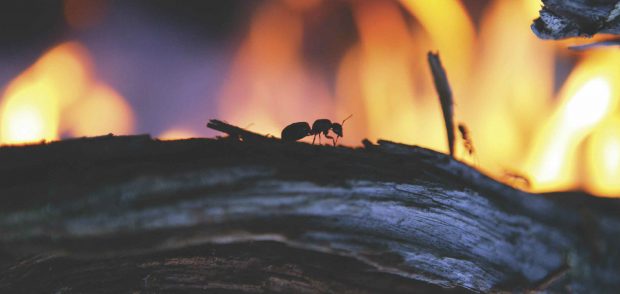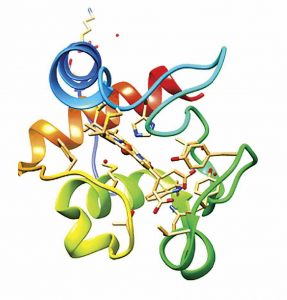 BIOLOGY: Assistant Professor of Biology Wallace Meyer
BIOLOGY: Assistant Professor of Biology Wallace Meyer
Fireproof Ants
Even a fire won’t keep a good ant down, according to research at the Robert J. Bernard Biological Field Station (BFS) on the effects of fire on ants. But which plants grow back after fire and drought does affect ant communities.
For her senior thesis, Tessa Adams ’16 was interested in determining if the ant community changed as a result of the September 2013 brush fire that charred 17 acres at the field station and The Claremont Colleges North Campus Properties. Expectations were that the effects of fire would be significant, but it turns out ants are a hardy, fireproof lot. Results show that there was minimal immediate and no lasting impact on the species from the fire, says Assistant Professor of Biology Wallace Meyer, director of Bernard Field Station, a preserve maintained by The Claremont Colleges that protects the rare native ecosystem of California sage scrub.
“It seems like ant assemblages can withstand a fire. And it makes sense—they are this super-organism. … Fast-moving hot fires affect the surface; meanwhile the ants are down below,” says Meyer. Plus, “fire is a natural component of the ecosystem.”
However, Meyer says, following a fire, areas of land can potentially convert from native flora—in the case of BFS, California sage scrub—to nonnative grasslands, which do affect whether ants return. (Rest assured, 22 species of ants are still making their home at BFS.) Drought, too, affects whether sage scrub or nonnative grasses grow back and which species of ants make their home in each type of habitat. In fact, Meyer says, drought—while not as manifestly dramatic—is actually a larger stressor than fire.
Meyer believes this research is significant because the effects of fire on anything other than plants and mammals are largely unknown. For purposes of conservation and biodiversity management, it is important to understand these effects, since fire is going to become more common, especially in light of global climate change. Adams’ research findings will be used in conservation management plans not only at BFS, but by managers throughout Southern California.
What are the implications for conservation management? First, as long as native plant communities recover, no action is required, says Meyer. Second, which types of plants grow back favors certain ant species. Third, effects of extreme drought correlated with climate changes are real and felt, making long-term management difficult.
Thanks to her high school AP Environmental Science class, Adams came to Pomona knowing she wanted to do ecology research. She says when she stepped foot into BFS, she was awestruck by the California sage scrub habitat.
Adams’ awe quickly turned into action. Adams started working on arthropod research at BFS as a volunteer her first year at Pomona and continued through the years, setting up research sites, collecting pitfall traps, sorting specimens that were collected—and she started seeing a wide range of arthropods at the station.
“After taking Professor Meyer’s Fire Ecology in Southern California class last spring, I became interested in how fire can shape an ecosystem, and I realized that there is little research on the effect of fire on arthropods. I decided to focus my thesis on the effect of fire on ants because the lifestyle of ants, which live in colonies, has the potential to be greatly affected by fire,” says Adams.
She conducted her research by pitfall trapping. She buried a test tube in the ground, with the lip of it level with the surface of the ground. The tube was filled about halfway with a preservation solution—either ethanol or propylene glycol. As the insects ran along the ground, they fell into the trap, and the collected specimens served as a survey of the insects present in an area.
But why choose ants? Adams points to the creatures as providing crucial ecosystem services that make them important to study because of their broad impact on other organisms and their value in helping to determine ways to conserve the environment they inhabit.
So in other words, remember the old proverb: Go to the ant … consider her ways.
—Sneha Abraham
 CHEMISTRY: Professor Roberto Garza-López
CHEMISTRY: Professor Roberto Garza-López
Molecular Origami
Pomona College Chemistry Professor Roberto Garza-López and his research colleagues have developed a new model that studies how protein molecules fold and unfold—work that has more than a few national institutes interested in the implications for understanding the development of diseases such as Alzheimer’s disease, Huntington’s disease, Type II diabetes and certain types of cancer.
The research, published in the Journal of Inorganic Biochemistry, looks at the protein called Cytochrome c, focusing on the questions of what happens to this protein’s molecules when they don’t fold properly and how this improper unfolding is linked to cancers and other diseases.
Why does a protein fold and unfold in the first place? Long protein molecules start straight, explains Garza-López, but in order to interact with other molecules, they have to fold. “And they have to fold into a very specific shape,” he says. “If they don’t fold properly, then that’s where negative things occur, especially disease. In the paper we published, we are looking at the opposite effect: we’re looking at the protein that is already folded to see how it unfolds.”
The Howard Hughes Medical Institute (HHMI) and the National Institutes of Health (NIH) are providing funding for further research and are interested in what the team’s findings reveal about the early development of diseases. Garza-López is working with Caltech Professor Harry B. Gray and DePaul University Professor John J. Kozak.
In order to visualize the protein molecule’s many folds, students working in Garza-López’s lab create 3-D structures of some of the proteins, like Cytochrome c (pictured here). “Students are very good with computers, at visualizing molecules and doing calculations, but they’re also very good at visualizing what those calculations are doing to those molecules.”
Sabari Kumar ’17, a chemistry major who is working in Garza-López’s lab, was acknowledged in the published paper and is now studying the folding and unfolding of proteins related to disease by performing molecular dynamics simulations.
The research by Garza-López , Gray and Kozak continues, and they’re already finished with another manuscript looking at another protein called Intelectin-1, a protein of the intestines and lungs that is able to distinguish between human cells and the cells of bacterial invaders. “This could underpin new strategies to fight infections,” says Garza-López. He adds: “Proteins are very complex. We start with a simple model and we do a lot with that model and try to understand new things about it. That’s how science works.”
—Carla Guerrero
